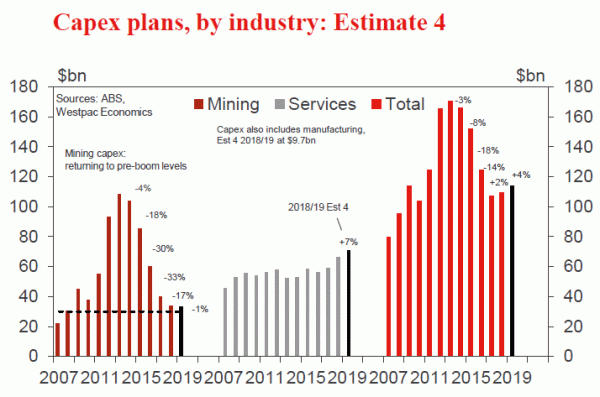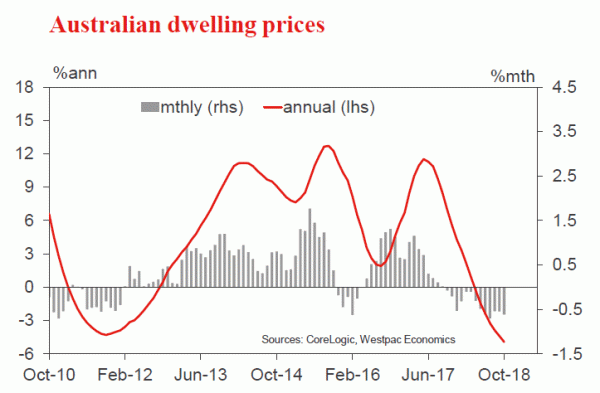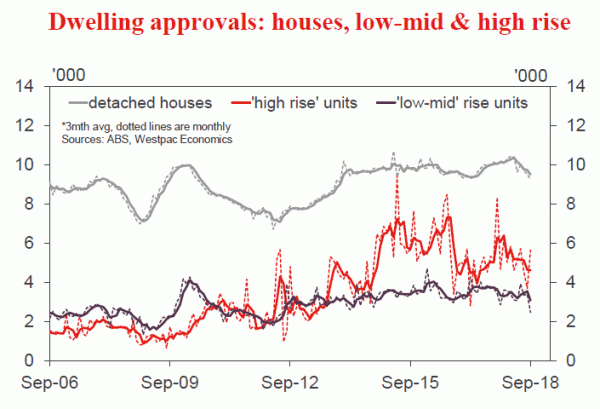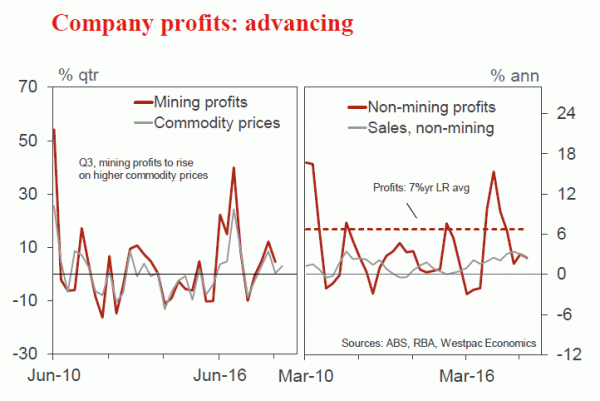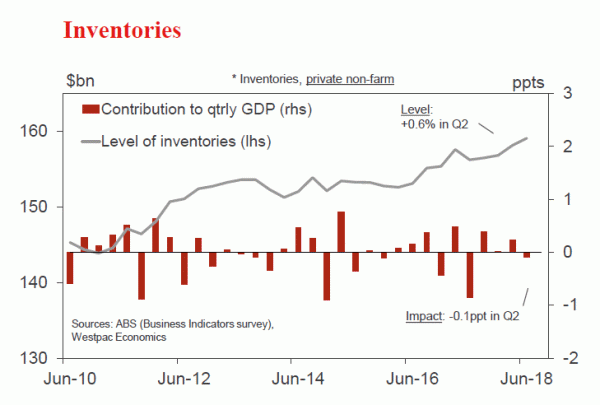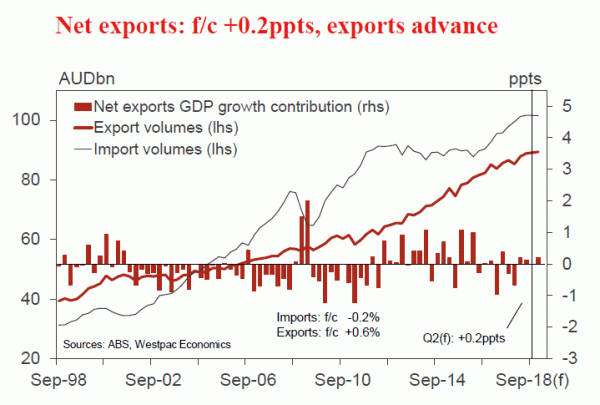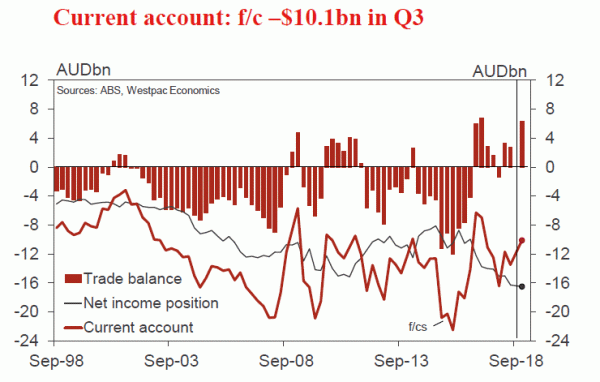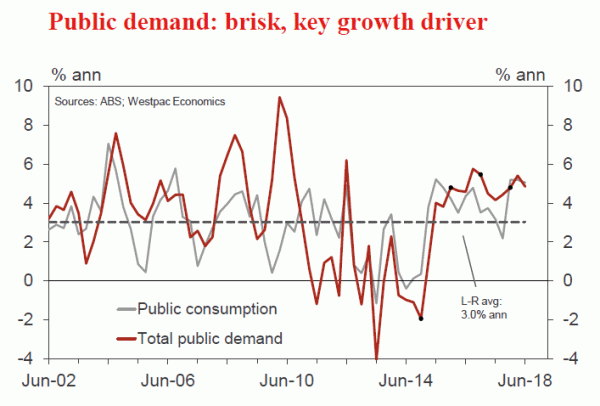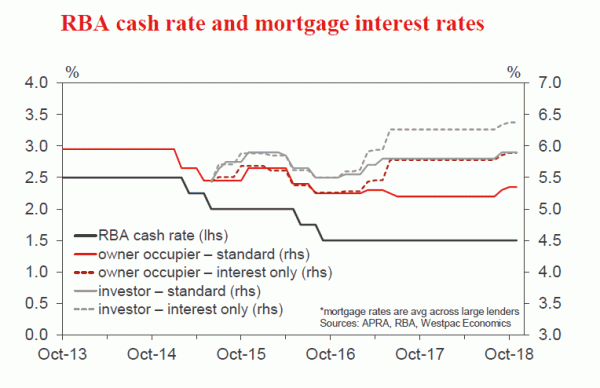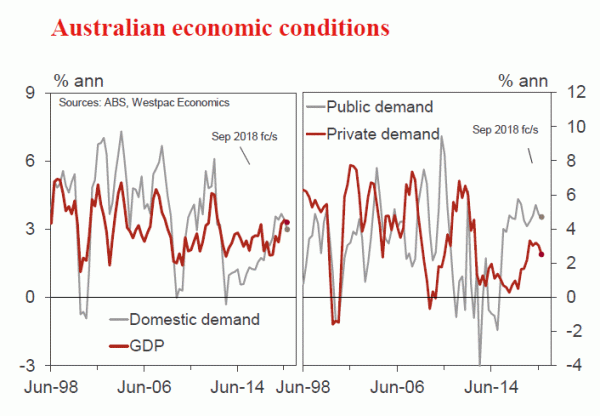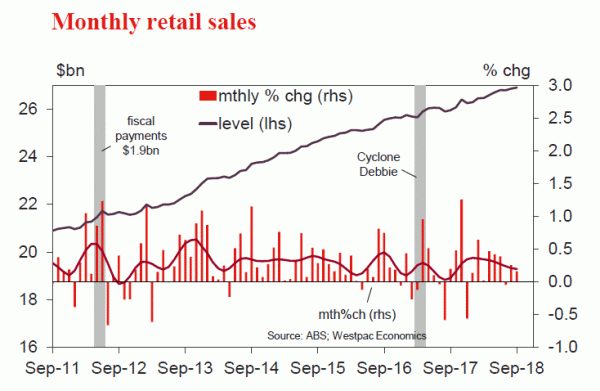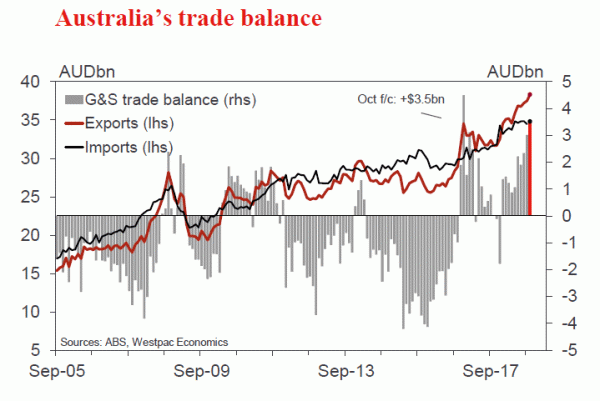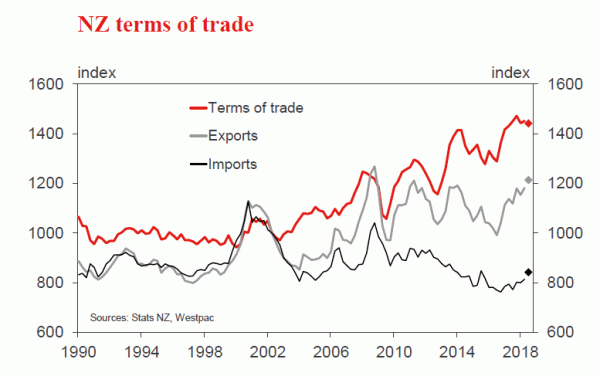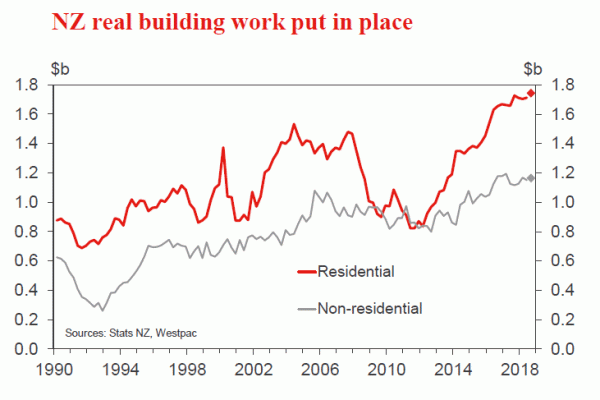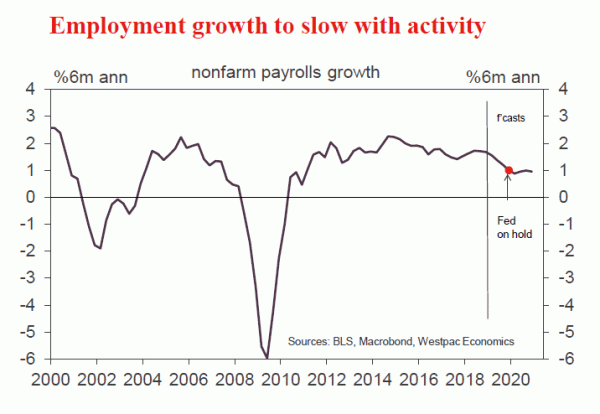Week beginning 3 December 2018
- Australia: Q3 GDP preview, housing slowing amidst overall robust conditions.
- RBA: policy decision and Deputy Governor Debelle speaking.
- Australia: Q3 partials and GDP, dwelling approvals and prices, retail, trade balance.
- NZ: terms of trade, building work put in place.
- China: Caixin PMI’s, foreign reserves.
- Europe: GDP 3rd estimate.
- US: nonfarm payrolls, Fed Chair Powell speaks, Federal Reserve Beige Book.
- Other central banks: BOC and RBI policy decisions, BOE Governor Carney speaks.
- Key economic & financial forecasts.
Information contained in this report current as at 30 November 2018.
Australia: Q3 GDP Preview, Housing Slowing Amidst Overall Robust Conditions
Reserve Bank in focus
The Reserve Bank Board meets this Tuesday and is certain to leave rates on hold at 1.50%. We continue to expect the RBA cash rate to remain on hold throughout 2019 and 2020.
Interest rates have been unchanged since a 25bps cut in August 2016, with the most recent hike in November 2010. That said, macro-prudential measures have seen a tightening of lending conditions for housing, triggering a cooling of the sector following a strong upswing.
The RBA expects further, but only gradual, progress in reducing unemployment and returning inflation towards the middle of the target band. A lift in wages growth will be key to achieving a sustained lift in inflation.
Q3 National Accounts
On Wednesday, the National Accounts will provide an estimate of economic activity for the September quarter. We expect output growth of 0.7%, with risks tilted to the downside. Annual growth holds steady at 3.4%, subject to revisions.
To set the scene, some key observations.
First, Australia’s output performance surprised to the high side over the past year, with growth at a well above trend 3.4%, including a 4.1% annualised pace over the first half of 2018. Domestic demand grew by a robust 3.4% over the past year, including a 3.0% increase in consumer spending and a 3.0% rise in overall private demand. The unemployment rate has fallen to a six year low of 5.0%.
Second, momentum has eased back in the second half of 2018, heading in to 2019, with the cooling of the housing sector, both prices and activity.
Third, the correction in the housing market is occurring against the backdrop of a robust economy. Notably, government spending is expanding at a brisk pace; elevated commodity prices (which are expected to slip from here) have boosted profits and tax revenue; businesses are increasing investment to meet the needs of a fast growing population; and the Australian dollar has moved lower, supporting the export sector.
Fourth, wages growth while off its lows and moving higher is still running at a sluggish pace. This, and high debt levels at a time of declining house prices, is a headwind for the consumer.
We continue to expect real GDP growth to moderate to around a trend 2.7% in 2019 as world growth eases and with uncertainty around the upcoming Federal election an added headwind.
Turning to the details of the quarterly national accounts.
The arithmetic of our Q3 GDP forecast is: domestic demand 0.5%; net exports, +0.2ppts and inventories a very small negative, rounding up to -0.1ppt.
By way of context, the June quarter arithmetic was: domestic demand 0.6%; net exports +0.1ppt; inventories flat; and statistical discrepancy +0.2ppts (i.e. the income and production measures of GDP outpaced the expenditure measure).
Labour conditions were robust in Q3, evidence the economy still had solid momentum. Total employment grew by 0.7%, with full-time employment +0.8%. and hours worked +0.4%.
On national income, the September quarter was a favourable one on higher global commodity prices, providing a boost to profits. The terms of trade rose by 1.2%, we estimate, to be 3.4% above the level of a year ago. For nominal GDP, we expect a Q3 outcome of 1.2%, with annual growth at a very healthy 5.8%.
Q3 GDP, detail
Household consumption (0.5%qtr, 2.8%yr): Consumer spending remains choppy quarter to quarter, with households selective in what they buy and when. After a robust Q2 outcome of 0.7%qtr, 3.0%yr, there was some loss of momentum in Q3. Retail sales had a softer quarter, +0.2% after a +1.0% in Q2, and vehicle sales weakened. Consumer Sentiment slipped during the quarter, dipping to 100.5 in September, following the change of Prime Minister and a rise in mortgage rates, but has recovered since, to 104.3 in November.
Additional detail in the national accounts around wage incomes and the household saving ratio will also be of key interest. Over the past year, households lowered their savings rate to partially fund consumer spending.
Dwelling investment (+0.4%qtr): Home building activity advanced in Q3, but growth slowed with conditions mixed. Renovations, also choppy, jumped by 4.5%, evidence that households are not overly cautious around their spending decisions. However, in a sign of things to come given the retreat in approvals, new home building activity declined by 1.6%, a turnaround from +3.2% and +3.6% in Q1 and Q2.
New business investment (-0.8qtr, flat yr): Investment turned the corner in 2017, advancing by 7%, after four years of decline. Key to this development was a greatly diminished drag from the mining investment wind-down and an uptrend in non-mining investment. In Q3, infrastructure activity fell by a reported 7.5% (led lower by mining); and non-residential building work declined by 2.2%, while equipment spending rose strongly, +2.2%. Capex plans for 2018/19 point to a lift in business investment in 2018/19.
Public spending (1.4%qtr, 4.7%yr): The public sector – directly accounting for almost a quarter of the economy – has been expanding at a well above trend pace from 2015 onwards. Public investment is trending sharply higher, off low levels, with a focus on long overdue transport projects. Health spending is also moving higher at a brisk pace. For Q3 we anticipate a robust 1.4% rise in public demand, – although there are some downside risks given a dip in public construction. Annual growth holds broadly steady at a brisk 4.7%.
Net exports (+0.2ppt, -0.2ppts yr): Net exports, a surprisingly large drag on growth in 2017, at -1.6ppts for the year, have swung around to be a small positive over the first half of 2018. Recently, exports resumed their uptrend and imports have advanced at a more modest pace. For Q3, net exports added a forecast 0.2ppts to activity. Exports grew by a forecast 0.6%, on services, manufacturing and LNG, while imports dipped, down 0.2%, including a decline in capital goods.
Private non–farm inventories (+0.5%, -0.1ppt contribution): Over the past year, inventories increased by a moderate 1.8% in response to rising domestic demand. For the September quarter, inventories are expected to expand further, albeit at a marginally slower pace, up a forecast 0.5%. Housing and consumer spending took on a softer tone in the quarter, weighing on the need to add to inventories.
Drought conditions, centred in NSW and surrounding areas, will dent farm output in 2018/19. While the impact on growth is expected to be greatest in the December and March quarters, the September quarter will not be immune – with this factor a potential downside risk to our forecast. Some negatives from the drought are included in our Q3 figuring, notably a decline in rural exports (cereal exports are at a 8 year low but meat shipments are at historic highs), as well as indirectly via the impacts on overall consumer and investment spending.
The week that was
This week, the FOMC and Brexit have been the focus globally. On the domestic front, investment partials were received ahead of next week’s Q3 GDP report.
Beginning offshore, comments by Chair Powell were taken as dovish by the market, the US 10-year touching the 3.00% level having started the week at 3.04%. Since then however, the 10-year has come back to 3.03%, leaving it effectively unchanged for the week. While Chair Powell did reference the federal funds rate as being “just below” estimates of neutral, context is key. ‘Estimates of neutral’ here refers to the 100bp range from 2.5% to 3.5% put forward by FOMC members, hence attaining a neutral stance could mean one hike or five. We expect that the total number of hikes to come is likely nearer the top of that range than the bottom. Our forecast is for four more, from December 2018 to September 2019. As per the FOMC’s own view, this forecast rests on the strength of underlying momentum in their economy, driven by the consumer. There are, of course, risks to this view. Chief among them are household wealth and sentiment and, for the business sector, the uncertainty created by US trade policy.
For the UK, in stark contrast to the US, the uncertainty felt by the market this week is a true reflection of current conditions. The only positive is that the date of the UK Parliament vote on the draft agreement has now been set, 11 December. Other than this announcement, headlines have carried dire predictions of the economic effect on the UK economy should a no deal Brexit occur, while numerous political interests have continued voicing their displeasure with the draft agreement and process. These are clearly troubling times for the UK, and this uncertainty will remain a threat for some time yet.
While in Europe, it is also worth covering President Draghi’s appearance before the EU Parliament’s Economic Committee. His remarks again highlighted their confidence in the Euro Area’s underlying momentum, albeit while recognising that the data received since his last appearance had been weaker than anticipated. In terms of their forecasts, one has to expect that the December ECB forecast update will see modest downward revisions; however, with regards to core inflation, their expectation of an uptrend remains intact, and with it their plans to end asset purchases at December. Whether the anticipated rate hikes past summer 2019 come to pass will depend on if the current growth slowdown leaves momentum above or below trend in 2019. We argue for the former, and hence continue to see the deposit rate inching towards zero from late-2019. Coming back to Australia, we received two opposing updates on investment for Q3 this week.
The construction work done release reported broad-based weakness across all components, with total activity down 2.8%. While we expect residential investment to continue declining over the coming year, the Q3 weakness in nonresidential construction is likely just a temporary blip given the considerable pipeline of work that remains in place for the sector. This is also the case for infrastructure investment, which is receiving material support from state government spending – particularly in NSW and Victoria.
In the CAPEX survey however, offsetting strength in equipment investment was seen, +2.2%. In the quarter, manufacturing provided the strength, while services was flat and mining declined. Important for the outlook, not only was the Q3 print an upside surprise, but so too were expectations for the 2018/19 financial year. Estimate 4 points to a 3–4% gain for investment in the current financial year, up from –1% at estimate 3. Also worthy of note, the sectoral mix of investment intentions was positive, with services and manufacturing leading the way. Our core view on investment remains for a modest gain in non-mining investment, spurred by the needs of a growing population.
Looking ahead to the GDP report next week, we anticipate a 0.7% increase in the quarter, leaving annual growth at 3.4%. To this view, based on the above investment data, risks are tilted to the downside. For all the detail of our forecast, see the GDP preview in our weekly. Further updates on components of Q3 GDP will be received next Monday and Tuesday ahead of GDP on Wednesday.
Finally for the week, the RBNZ has released their latest Financial Stability Report. As expected, the RBNZ eased its loan-to-value limits on mortgage lending after price and credit growth slowed to be broadly in line with income growth. However, it was also announced that banks will be required to hold more capital. Our NZ team note that the latter is a preliminary decision with a consultation paper to follow.
Chart of the week: capex 2018/19 plans estimate 4
The Est 4 on Est 4 figures by industry are: mining -1% (vs -4% 3 months ago); services is +7% (from flat) and manufacturing +7% (from +3%). Using calculation based on average realisation ratios (RRs), we estimate that Est 4 implies capex spending in 2018/19 will be 3.4% above that in 2017/18 (broadly in line with the Est 4 on Est 4 of +4.4%). By industry, using RRs we estimate: mining -10%; services +10% and manufacturing +8%.
In terms of key themes, mining investment will move lower in 2018/19, while non-mining investment is in an uptrend. Construction of the remaining gas projects was recently completed, which will see mining capex decline near-term ahead of an emerging stabilisation. Our central case forecast is for modest gains in non-mining investment to meet the needs of a growing population. This is broadly consistent with this capex survey update and other indicators ~ notable a sizeable pipeline of non-residential building work and the uptrend in infrastructure work, particularly investment in renewables power generation.
New Zealand: week ahead & data wrap
Easy does it
The Reserve Bank has announced a further easing of its mortgage lending restrictions, as we expected. These changes, along with the recent falls in mortgage rates, are likely to see the housing market liven up over the coming months, adding to the flow of positive signals for the local economy. However, we still think that markets are misreading how the Reserve Bank will respond to the economic data, and that official interest rate hikes are some time away.
In its latest six-monthly Financial Stability Report the RBNZ announced a further easing of its restrictions on high loanto- value ratio (LVR) mortgage lending, following the modest easing that was announced a year ago. The ‘speed limit’ for owner-occupier loans – the share of lending that can be above an 80% LVR – will be raised from 15% to 20%. For investor loans, the effective cap on LVRs will be raised from 65% to 70%. Both changes will take effect from the start of next year.
While household debt levels remain high, the growth in house prices and credit has moderated in recent years, and is now more broadly in line with household income growth. The LVR restrictions have no doubt played a part in this moderation. But since they were first introduced in 2013, they have been joined by a range of other forces that have dampened housing demand. Policies such as the ‘bright-line test’ for taxing capital gains have targeted investor demand in particular, while the banking sector has moved to tighten lending standards in recent years.
We’d expect the housing market to respond to these LVR changes in a similar way to what we saw last year. Banks increased their high-LVR lending, but maintained a sizeable buffer below the maximum levels. Much of the additional leeway on owner-occupier lending appears to have gone towards first-home buyers. House price growth did pick up a little in early 2018, but it’s hard to distinguish between the impact of the LVR changes and the drop in mortgage rates around the same time.
Similar conditions prevail this time – in fact, there has been quite a sharp fall in mortgage rates in recent months. Consequently, we’re expecting the housing market to be a bit livelier in the next few months. However, we still expect government policies and an eventual rise in interest rates to keep house prices subdued over the next few years as a whole.
A livelier housing market would add to the signals of a stronger economy that we expect to see over 2019. Rising house prices tend to support consumer spending growth, government spending is accelerating from its previous pace, and a large pipeline of approved work will support construction activity. We’re forecasting GDP growth to pick up to 3.2% next year, after slowing to 2.9% growth over 2018.
Financial markets will need to carefully consider what a stronger economy holds in store for monetary policy. We’ve seen some quite strong reactions to recent RBNZ policy reviews. In August the RBNZ said that it was nearing the threshold for cutting the OCR; market interest rates fell sharply, with some fixed-term mortgage rates falling to new record lows. But in November, when the RBNZ acknowledged that the economy had outperformed its forecasts, interest rates and the New Zealand dollar moved sharply higher again. Interest rate markets are now pricing some chance of an OCR hike by the end of 2019.
We’re still of the view that the recent market reaction has been overcooked. The RBNZ sent a clear signal about its intentions in its November Monetary Policy Statement: when faced with a stronger outlook for the economy, it chose to take this as higher inflation (and higher employment) rather than higher interest rates. Its projected path for the OCR was identical to August, with no hikes until well into 2020.
We’d also point out that, unlike in the previous quarter, the economy is not currently outperforming the RBNZ’s forecasts. This week’s retail trade report showed that sales volumes were flat in the September quarter. The result was surprising given the strength in electronic card spending over the quarter, but nevertheless this is what will go into the GDP figures. Soft retail spending supports our view that September quarter GDP will see a more modest gain of 0.7% after the whopping 1% rise in the June quarter.
As for inflation pressures, recent developments have actually been to the downside. World oil prices have fallen sharply, from a peak of around US$85 a barrel for Brent crude in early October to below $60 a barrel today. Accordingly, petrol prices have fallen to their lowest levels since May (despite an increase in fuel taxes since then).
Meanwhile, the New Zealand dollar has strengthened to its highest level against the US dollar since June. Some of that is due to market perceptions that the RBNZ will hike rates sooner. But more recently we’ve also seen a weaker US dollar, as softer economic data in the US has led to speculation that the Federal Reserve could slow the pace of its rate hikes.
We should point out that the RBNZ’s forecasts of near-term inflation are still on the low side (with a pickup in later years). But it’s looking less likely that they will be grappling with upside surprises at their next review in February. And a softer US economy, lower fuel prices and a high New Zealand dollar would all make the RBNZ even less inclined to signal OCR hikes any time soon.
Data Previews
Aus Nov CoreLogic home value index
- Dec 3, Last: –0.5%, WBC f/c: –1.0%
Australia’s housing market continues to correct. The CoreLogic home value index fell 0.6% in October to be down 4.6%yr, revisions accentuating the annual decline. The correction continues to be more pronounced for the previously strong Sydney and Melbourne markets, with Perth’s longer running adjustment continuing but prices stable across the other major capital cities.
November looks to have been an even weaker month, auction clearance rates dropping to previous cycle lows in Sydney and Melbourne. The daily index points to a 1.0% drop in prices nationally with the cumulative price adjustment across the five major capital cities now close to 6% since last September’s peak.
Aus Oct dwelling approvals
- Dec 3, Last: 3.3%, WBC f/c: –3.0%
- Mkt f/c: -1.5%, Range: -4.0% to 3.0%
Dwelling approvals rose 3.3% in September, reversing part of the 13% slide over the previous two months. However, the detail was weak with the monthly gain centred on Victoria high rise units and approvals outside of this narrow state segment significantly weaker (our estimates suggest total dwelling approvals ex Victoria high rise were down about 7.5%mth).
The October update looks likely to show a fall with some risk that this may be sharp. Housing markets have weakened significantly since mid year. Site purchases continue to point to lower high rise activity while construction-related finance approvals suggest non-high activity will remain weak, stabilising at best. On balance, we expect a 3% decline in total approvals with risks skewed to the downside.
Aus Q3 company profits
- Dec 3, Last: 2.0%, WBC f/c: 1.3%
- Mkt f/c: 2.8%, Range: 1.0% to 4.0%
Companies are enjoying rising profits on the back of higher commodity prices and, over the past year, above trend economic growth.
In the June quarter, profits grew by 2.0%, including +4.4% for mining and +0.6% across the non-mining sectors.
For Q3, profits are forecast to rise by 1.3%.
Mining profits will likely be the source of strength, up by 3% or more, underpinned by a further lift in commodity prices.
Non-mining profits are expected to move a little higher, with the risk that results are mixed across industries. A negative is softer conditions for housing and retail, while other sectors such as manufacturing and potentially business services are likely to fare better.
Aus Q3 inventories
- Dec 3, Last: 0.6%, WBC f/c: 0.5% (-0.1ppt)
- Mkt f/c: 0.4%, Range: -0.1% to 0.5%
Over the past year, inventories increased by a moderate 1.8% in response to rising domestic demand.
In the June quarter, inventories expanded by 0.6%, with a lift in mining (which more than outweighed a temporary dip in manufacturing) and with a 0.7% rise across other sectors.
For the September quarter, inventories are expected to expand further, albeit at a marginally slower pace, up a forecast 0.5%. Housing and consumer spending took on a softer tone in the quarter, weighing on the need to add to inventories.
This would see inventories make a very small subtraction from growth in Q3, in the order of -0.1ppt.
Aus Q3 net exports, ppt’s cont’n
- Dec 4, Last: +0.1, WBC f/c: +0.2
- Mkt f/c: +0.3, Range: +0.1 to +0.5
Net exports were a surprisingly large drag on growth in 2017, -1.6ppts for the year. Imports accelerated, associated with a turnaround in business investment, and exports stumbled, stalling over the year.
Over the first half of 2018, net exports swung around to be a small positive for growth, +0.2ppts in Q1 and +0.1ppt in Q2. Exports have resumed their uptrend and imports advanced at a more modest pace.
For the September quarter, net exports added a forecast 0.2ppts to activity.
Exports grew by a forecast 0.6%, on services, manufacturing and LNG, while rural goods and iron ore declined.
Import volumes appear to have dipped in the quarter, down around 0.2%, including a decline in capital goods.
Aus Q3 current account, AUDbn
- Dec 4, Last: -13.5, WBC f/c: -10.1
- Mkt f/c: -10.2, Range: -12.2 to -9.9
Australia’s current account deficit is relatively well contained currently, at 2.9% of GDP in the June quarter.
In the June quarter, the deficit was $13.5bn, with a trade surplus of $2.8bn (since upgraded to $4.2bn) and an income deficit of $16.3bn.
For the September quarter, the current account is set to narrow, improving to a deficit of $10.1bn.
Key to the improvement is a larger trade surplus, increasing to $6.4bn on higher export earnings. The terms of trade rose by 1.2%, we estimate, driven by commodity prices.
The net income deficit is expected to increase to $16.5bn, up sharply over the past two years from $10bn. Over this period, the deficit increased largely due to rising returns to foreign investors in the mining sector.
Aus Q3 public demand
- Dec 4, Last: 0.6%, WBC f/c: 1.4%
The public sector – directly accounting for almost a quarter of the economy – is a key growth driver, expanding at a well above trend pace in 2015, 2016 and 2017, with annual growth at 4.8%, 5.5% and 4.8%, respectively. This brisk momentum has extended into 2018.
Public investment is trending sharply higher, off low levels, with a focus on long overdue transport projects. Health spending (included in ‘consumption’) is also moving higher at a brisk pace.
In the June quarter, total public demand grew by a more modest 0.6%, dented by a 1.3% fall in public investment.
For Q3 we anticipate a robust 1.4% rise in public demand, – although there are some downside risks given a dip in public construction work. Annual growth in public demand holds broadly steady at a brisk 4.7%.
Aus RBA policy announcement
- Dec 4, Last: 1.50%, WBC f/c: 1.50%
- Mkt f/c: 1.50%, Range: 1.50% to 1.50%
The Reserve Bank will leave interest rates unchanged at 1.50% at the December meeting. We continue to expect rates to be on hold throughout 2019 and 2020.
The last time official rates were lowered was August 2016 and the last RBA rate hike was November 2010. That said, macro-prudential measures have seen a tightening of lending conditions for housing, triggering a cooling of the sector following a strong upswing.
Notably, the correction in the housing market is occurring against the backdrop of a robust economy. Growth has been above trend and unemployment has fallen to a six year low.
The RBA expects further, but only gradual, progress in reducing unemployment and returning inflation towards the middle of the target band. A lift in wages growth, from the current sluggish pace, will be key to achieving a sustained lift in inflation.
Aus Q3 GDP
- Dec 5, Last: 0.9%qtr, 3.4%yr, WBC f/c: 0.7%qtr, 3.4%yr
- Mkt f/c: 0.6%, Range: 0.4% to 0.9%
Australia’s output performance surprised to the high side over the past year, at a well above trend 3.4%, including a 4.1% annualised pace over the first half of 2018.
For Q3, momentum eased back to around a trend pace, at a forecast 0.7%qtr – albeit with risks tilted to the downside. That leaves annual growth at 3.4% (subject to revisions).
Key to some slowing between Q2 and Q3 is the cooling of the housing sector, both prices and activity, as well as an ongoing choppy profile for consumer spending.
The arithmetic of our GDP forecast is: domestic demand 0.5%; net exports, +0.2ppts and inventories a very small negative, rounding up to -0.1ppts. Labour conditions were robust in Q3, employment +0.7%, evidence that the economy still had solid momentum.
Aus Oct retail trade
- Dec 6, Last: 0.2%, WBC f/c: 0.1%
- Mkt f/c: 0.3%, Range: 0.0% to 0.5%
September retail sales were on the soft side, rising 0.2% in the month, holding annual growth at 3.7%yr. Sales have been tracking closer to a 3.3% annual pace over the last six months. The detail showed gains in the month concentrated in food categories (up 0.5% on a combined basis) with non food retail declining 0.2%mth.
Indicators have been mixed in October. Consumer sentiment lifted a little to be slightly above average. Private business surveys showed soft readings amongst retail responses to the NAB survey but a lift in the AiG PSI. Anecdotal reports have tended to be on the soft side. Weakening housing markets may also be starting to affect demand with vehicle sales suggesting spending on big ticket discretionary items has weakened (although this may also be due to changes to vehicle finance). On balance, we expect October to show a subdued 0.1% gain taking annual growth to 3.3%yr.
Aus Oct trade balance, AUDbn
- Dec 6, Last: 3.0, WBC f/c: 3.5
- Mkt f/c: 3.0, Range: 2.0 to 3.7
Australia’s trade account has been in surplus every month so far in 2018.
In September, the surplus climbed to $3.0bn.
For October, we expect the surplus to rise higher, to $3.5bn, the largest surplus since the end of 2016.
Export earnings are up a forecast 2.2%, +$0.8bn. Key is a rebound in coal volumes from the supply disruptions of the past couple of months. Commodity prices were also higher in the month.
The import bill is forecast to rise by around 1.0%, +$0.3bn. Volumes are expected to resume their uptrend, emerging from the softness of Q3, while prices are higher associated with rising global energy prices and a lower dollar (down 1.4% against the US dollar to 71¢ in October).
NZ Q3 terms of trade
- Dec 3, Last: +0.6%, WBC f/c: -0.7%, Mkt f/c: 0.2%
New Zealand’s terms of trade have edged back slightly after reaching an all-time high in 2017. We expect a 0.7% drop for the September quarter, unwinding the 0.6% rise in the June quarter.
We expect a 2.7% rise in export prices overall, led by a 7% rise in dairy prices. Other commodity exports saw modest price gains, largely as a result of the lower New Zealand dollar over the quarter.
The rise in dairy export prices is likely to be outweighed by a 14% surge in oil import prices. We also expect small price gains for other imports (mostly manufactured goods), again due to the lower exchange rate.
NZ Q3 building work put in place
- Dec 5, Last 0.8%, Westpac f/c: +2.3%, Mkt f/c: 2.3%
Building activity rose by 0.8% in the June quarter, reversing the small drop in the previous quarter. Underlying this rise was a 1.2% increase in non- residential activity, as well as a 0.5% increase in residential construction.
We’re expecting a 2.3% increase in overall building activity in the September quarter, supported by gains in both residential and non-residential building. On the residential front, we expect building levels to increase by 1.8% in September with gains centred on Auckland. That follows a large pickup in dwelling consent issuance in the region over the past year. This is helping to offset the continued softening in Canterbury, while conditions in other regions remain firm. We also expect a 3% increase in non- residential construction, with increases spread across the retail, industrial and accommodation sectors. Public sector building work is also increasing slowly.
US Nov employment report
- Dec 7, nonfarm payrolls, last 250k, WBC 200k
- Dec 7, unemployment rate, last 3.7%, WBC 3.7%
- Dec 7, hourly earnings %yr, last 3.1%, WBC 3.2%
The average monthly gain for nonfarm payrolls has been very steady this year. On a 3 and 6 month basis, and for the year to date, the month-average pace is 218k, 216k and 213k respectively. All of these outcomes are well above the pace necessary to keep the unemployment rate unchanged, indicating demand for labour remains strong.
This strength in employment will see downward pressure remain on the unemployment rate, though the next step lower is more likely in a few months time than November.
Hourly earnings have been picking up momentum over the past year and, given full employment, this is expected to continue. An annual rate a little above 3.0%yr is expected near term, before a further firming to circa 3.5% mid-2019.




